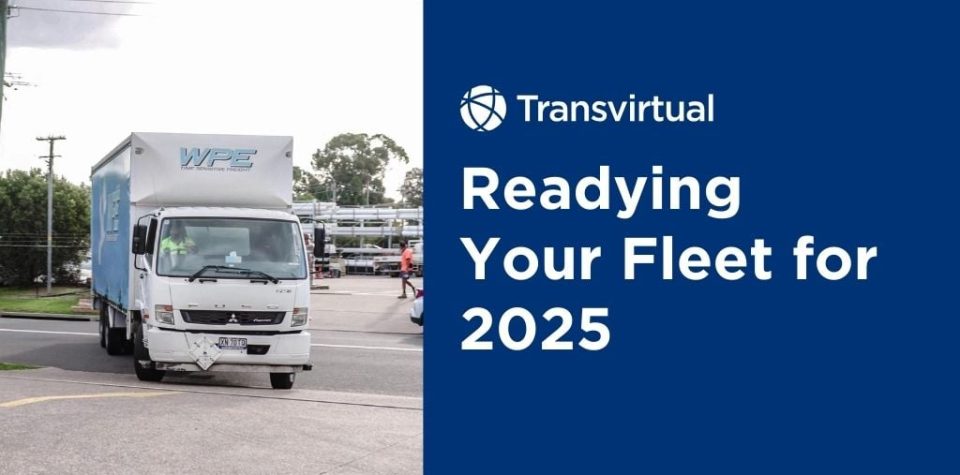Table of Contents
The Christmas/New Year break is a perfect time to get your fleet serviced and your facilities ready for action when 2025 kicks off.
Where did 2024 even go? The Festive Season is upon us…again! As we bid farewell to 2024 and welcome the holiday cheer it is a perfect opportunity to ensure your logistics fleet and facilities are primed for a productive start to the year.
It probably only feels like yesterday that you and your staff were navigating through winter. And now, as the year draws to a close, you will no doubt be as busy as ever. Of course, in the logistics game, there’s never a real “quiet time.” But with the anticipated downtime during the Christmas and New Year period on the horizon, it’s the ideal moment to schedule your yearly maintenance to ensure your equipment is in peak condition.
At Transvirtual,we know that our logistics software systems are a perfect way to plan and action maintenance schedules. You can use the holiday season as a period when you can send your vehicles and plant the service centre to give ‘em the ol’ once over. So here are a few ways you can take advantage of the holidays to get your gear in shape while you get your gear off at the beach.
The Philosophy of Vehicle Maintenance
The type of logistics industry you’re in determines the maintenance needs of your plant and equipment. You might operate in highly corrosive or dusty environments such as Outback trucking, servicing the mining industry or operating beside the ocean. Alternatively, your gear may be subjected to lots of stop/start work, such as urban deliveries, mail runs or frequent distribution centre drop-offs.
Regardless of the work environment, choosing the correct maintenance plan can be an important way of minimising downtime and avoiding unnecessary spare parts and consumables consumption. Predictive maintenance, which uses AI and IoT technologies to anticipate maintenance needs, can significantly reduce unplanned downtimes and ensure efficient operations.
In general terms, maintenance regimes can be divided into four categories.
1. Corrective Maintenance
That busted radiator hose that you’ve had bound up with gaffer tape and tie-wire since March… time to get it fixed, ASAP.
Sometimes, those on-the-spot fix-it jobs work fine when you’re under pressure and need to keep going. As every logistics operator knows, occasionally the best repair jobs are the ones where you cobble together the necessary parts to MacGyver your way through a job.
But no matter how well you’ve tied that Cobb & Co twitch, sooner or later it’s going to give way. Without proper maintenance, a catastrophic blowout or failure may occur down the line, and the resulting cost of a big repair job can far exceed the cost of getting a smaller fault fixed properly. A corrective maintenance programme will list repairs that need to be done so they can be taken care of before they can cause bigger (and more expensive) problems.
2. Preventative Maintenance
This type of maintenance is carried out at predetermined intervals and may take in a selection of different factors such as oil changes, filter replacement, lubrication, and drive belt inspection. Sometimes, this type of maintenance is carried out as part of a warranty programme requiring the vehicle to be serviced at certain intervals following purchase.
Preventative maintenance can also include such things as renewing anti-corrosion coatings, checking and repairing wiring looms, and re-calibrating electronic systems, including driver assistance features. Maintenance cycles such as this aim to reduce the chance of failure or diminished performance during the period between each inspection, and to prolong the working life of the vehicle.
The Christmas/New Year break is a perfect time to perform preventative maintenance as it occurs at a set time of the year when vehicles, plant and machinery are more likely to be idle.
3. Risk-based Maintenance in Fleet Management Solutions
This type of maintenance relies on accurate record-keeping along with integrated analysis, measurement and periodic testing. Maintenance type and frequency can then be assigned to each piece of plant or equipment depending on the work that the vehicle is doing.
For example, a long-distance delivery truck may have the welds on its chassis inspected occasionally to pick up any hairline cracks or sloppy couplings caused by rough Outback roads. Alternatively, a machine such as a city delivery truck might have its seals inspected at set intervals based on how much work it has been doing and the type of urban conditions it has been working in.
A risk-based maintenance framework might be set up to look something like this:
Collect data. For each identified risk, data needs to be collected to provide information about the risk, what the consequences of it might be, and what methods can be employed to mitigate it.
It is also important to integrate carbon tracking features to monitor and reduce carbon emissions as part of a broader strategy to achieve greener solutions.
Evaluate risk. Each risk can be evaluated according to how likely it is to occur and what its effects on the operation would be.
Rank risks from highest to lowest. This enables you to decide which repairs need to be undertaken immediately and which ones can be left until the next inspection cycle.
Create an inspection plan. This can take the form of an ongoing condition monitoring plan for less urgent repairs, and a preventative/restorative plan for maintenance that has to be taken care of straight away.
Propose mitigation or repair. Now that you know what you are dealing with, you can assign each piece of plant to the appropriate repair facility or engage technicians to visit your workplace to implement on-site repairs.
Reassess. What worked; what didn’t work? How efficient was the maintenance process and can we schedule these risk-based maintenance checks into our preventative maintenance framework?
4. Condition-based and Predictive Maintenance
OK…let’s cut to the chase here. That “check engine light” that’s been lit up on the dashboard of the ute since 2014: well, that’s a perfect example of condition-based maintenance right there! On-board detection equipment and sensors are installed to indicate when servicing is required. Adaptive cruise control, as an example of advanced driver-assistance systems, uses on-board sensors to enhance vehicle safety and efficiency.
Maintenance should be carried out whenever indicators give the signal that equipment is deteriorating and the risk of failure is consequently increasing. This maintenance strategy can drastically reduce the long-term cost of repairing a serious breakdown that could have been avoided if Bruce, the vehicle’s driver, had just told you that a warning light was on!
Preparing for the New Year
As the new year approaches, it’s essential for fleet managers to review their current fleet management practices and set goals for the upcoming year. This proactive approach ensures that your fleet management solutions are optimized and ready to tackle the challenges of 2025.
Reviewing Current Fleet Management Practices
Reviewing your current fleet management practices is crucial to identify areas of improvement and optimize your fleet operations. Here are some key aspects to consider:
Fleet size and composition: Assess your current fleet size and composition to determine if it’s aligned with your business needs. Are there vehicles that are underutilized or overworked? Adjusting your fleet size can enhance overall fleet performance.
Vehicle maintenance: Review your vehicle maintenance schedule to ensure that it’s up-to-date and effective in preventing breakdowns. Regular maintenance not only prolongs vehicle life but also enhances vehicle performance.
Fuel consumption: Analyze your fuel consumption patterns to identify opportunities for reduction and cost savings. Implementing strategies to reduce fuel consumption can significantly cut operational costs.
Driver performance: Evaluate your drivers’ performance to identify areas for improvement and provide training where necessary. Enhancing driver performance through regular training can lead to safer and more efficient fleet operations.
Setting Goals for Fleet Managers
Setting goals for fleet managers is essential to ensure that they’re working towards common objectives and optimizing their fleet operations. Here are some examples of goals that fleet managers can set:
Reduce fuel consumption by 10% within the next 6 months: Implement fuel-saving strategies and monitor progress regularly.
Improve vehicle maintenance schedules to reduce breakdowns by 20%: Enhance your maintenance routines to ensure vehicles are always in top condition.
Enhance driver performance by providing regular training and feedback: Regular training sessions can help drivers adopt best practices and improve their performance.
Increase fleet efficiency by 15% through route planning software and optimization: Utilize advanced route planning software to optimize routes and reduce travel time and fuel usage.
Fleet Technology Trends
The fleet management sector is constantly evolving, with new technologies there to improve fleet operations and efficiency. Staying updated with the latest fleet management trends can give you a competitive edge and enhance operational efficiency.
Embracing Alternative Fuels and Fleet Electrification
Alternative fuels and fleet electrification are becoming increasingly popular as fleet managers seek to reduce their environmental impact and operating costs. Here are some benefits of embracing alternative fuels and fleet electrification:
Reduced fuel consumption: Alternative fuels and electric vehicles can significantly reduce fuel consumption and lower operating costs. This not only saves money but also contributes to a greener environment.
Lower emissions: Alternative fuels and electric vehicles produce lower emissions, making them a more environmentally friendly option. This can help fleet managers meet regulatory requirements and improve their company’s sustainability profile.
Improved fleet efficiency: Alternative fuels and electric vehicles can improve fleet efficiency by reducing maintenance needs and extending vehicle lifespan. Electric vehicles, for instance, have fewer moving parts, which means less wear and tear and lower maintenance costs.
Some popular alternative fuels and electric vehicles include:
Electric vehicles (EVs)
Hybrid vehicles
Biodiesel
Compressed natural gas (CNG)
By embracing alternative fuels and fleet electrification, fleet managers can reduce their environmental impact, lower operating costs, and improve fleet efficiency. This forward-thinking approach not only benefits the environment but also enhances overall fleet performance.
Don’t Forget the Shed…or The Yard.
With less staff around to get in the way of the property maintenance crew, the end-of-year break is a perfect time to get your work base tidied up.
Critters and leaks
Having your distribution facilities and vehicle sheds cleaned, bird-proofed, re-painted or insect-proofed while everyone is away on holiday makes sense. Use this time to get the spouting cleaned out, any leaks repaired and maybe even get some new signage installed.
Do the Hard Yards to Reduce Fuel Consumption
Potholes are a pain. So are overhanging trees, long grass and general junk. Every yard needs tidying up occasionally, so use the summer break to get Groundskeeper Willy around to fill in the holes, get rid of the old drums and whatnot, and give the grass a mow.
Happy Holidays!
The summer holidays are a time to relax, reconnect with your family, recharge your batteries and forget about work for a while. So organising your plant and property maintenance to coincide with this is an excellent way of minimising the time your gear is idle when the New Year kicks off.
But you have to be organised. After all, the people who maintain and service plant and machinery will also be wanting some time off over the Christmas/New Year period. So if you would like to explore the ways that our logistics software systems can help you plan and action your maintenance schedules, give us a call.
At , we hope that your year has been a success and that 2025 will be even bigger. We hope you have enjoyed reading our blog post this year and we look forward to bringing you lots more interesting and useful articles in the New Year. Wishing all of our customers present and future a very happy holiday season.


